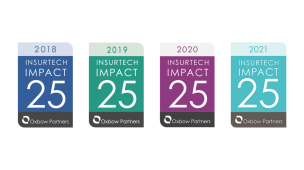Why InsurTech now matters for corporate and specialty insurers
March 28, 2018 Chris Sandilands
When InsurTech sprung to prominence in 2015, most startups were focusing on personal lines ‘disruption’. Our August 2016 infographic showed that 75% of InsurTechs were targeting personal lines and 56% were focusing on distribution. Most corporate and specialty insurers concluded that InsurTech presented no threat and only limited opportunity and continued with business as usual.
That was then, and now is now. InsurTech now matters for corporate and specialty insurers.
(Incidentally, we agree with the point Adrian Jones, Head of Strategy & Development at SCOR, makes in this excellent article: it’s a myth that InsurTech has been around only since 2015. We do however believe that there has been a new thrust since then, harnessing the pace and power of new technologies.)
2015-2017: The first wave of InsurTech
It is not surprising that InsurTech started as a personal lines ‘disruption’ play. Entrepreneurs, buoyed by what was happening in FinTech and other industries, saw huge opportunities to make insurance more ‘customer centric’ based on their own experiences. They wanted to simplify insurance (e.g. Sherpa), offer more tailored propositions (e.g. Bought By Many) or change the whole insurance paradigm (e.g. Guevara).
But the truth is that insurance has not been disrupted over the last three years, and it’s hard to see that this is about to change. As Adrian illustrates in another article, even the most prominent ‘disruptors’ in the US (Lemonade, Metromile and Root) are finding the going tough and burning through a lot of capital, whether directly or via reinsurance.
We argue in our InsurTech Impact 25 paper (February 2018, page 7) that many ‘Distribution InsurTechs’ – the name we give to InsurTechs trying to ‘disrupt’ markets – are not scratching sufficiently major customer itches to be worth the switching cost for those consumers. As a result, it remains the case that the perceived potential of ‘Distribution InsurTechs’ is worrying incumbents far more than their actual performance to date.
2018: The second wave of InsurTech
If we were to update our InsurTech landscape infographic, ‘Supplier InsurTechs’ would feature much more prominently. These companies are developing technology (or as in the case of German InsurTech Kasko, have repurposed consumer propositions) to help incumbent insurers, reinsurers and brokers operate more effectively. They have found getting traction in consumer markets tough, and are developing technologies or techniques that they can sell to the established insurers.
Many of these companies are targeting corporate and speciality underwriters. This is perhaps not surprising – at least not from the UK perspective. UK personal lines insurers have been investing in pricing capabilities, efficiency and fraud analytics for years as competition has become cut-throat on aggregators and relationships impersonal. They are mostly advanced in many areas.
This is in strong contrast to corporate and specialty classes, where much underwriting is still ‘judgement’ based, processes are manual and underwriters and risk managers are resigned to poor data quality. As such, we believe that many of the Impact 25 Members can be valuable for corporate and specialty underwriters in 2018. Some examples are below:
- Insurdata was set up by ex RMS executive Jason Futers and helps (re)insurers obtain more accurate building location information. This is helpful for underwriting (e.g. commercial property, reinsurance portfolios), risk management and portfolio reviews. (here)
- Risk Genius uses AI to ‘read’ policies and understand coverage. Founder Chris Cheatham noted recently “[My trip to] London was amazing. It took two days for one very big learning to sink in: underwriters in Europe are empowered to manuscript with little or no formal approval process.” His business allows corporate insurers get a better understanding of their exposures. (here)
- Flock is an analytics platform currently used to price drone flights dynamically, for example taking into account hyper-local weather conditions and locale of flight. The technology’s ability to process ‘big data’ quickly could be helpful for commercial IoT propositions, for example. (here)
- Cape Analytics and Geospatial Insight generate underwriting or claims insight from aerial imagery. This is useful, for example, in natcat losses when (re)insurers need to assess their exposures quickly. (Cape Analytics: here; Geospatial Insight: here)
What it means for corporate and specialty insurers
Technology is not, of course, a new phenomenon in corporate and speciality insurance. However, the speed of proliferation of new vendors (of both technology solutions and data sources) is arguably unprecedented. It challenges the corporate ‘clock speed’ of most incumbents and will present opportunities to successful adopters to tilt industry profits in their direction.
But identifying the correct response is challenging for incumbents and, as we argue in our Impact 25 paper, there is no single, correct course of action. Choices that need to be made broadly fit into three categories:
- Strategy: Should we focus on customer experience / proposition or efficiency?
- Technology: Do we build or partner or buy? If we partner, how do we create and protect differentiating IP?
- Execution: Should we innovate within the business or in dedicated teams? What structures and processes do we need?
These questions – amongst others – need to be answered to ensure an effective corporate response.




